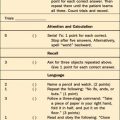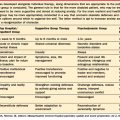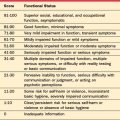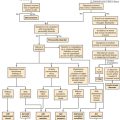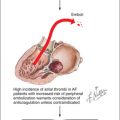CHAPTER 29 Mood Disorders: Major Depressive Disorder and Dysthymic Disorder
UNIPOLAR DEPRESSIVE DISORDERS: CLINICAL FEATURES
Patients who suffer from unipolar depressive disorders typically have a constellation of psychological, behavioral, and physical symptoms. Tables 29-1 through 29-3 list some of the most common psychological and cognitive (Table 29-1), behavioral (Table 29-2), and physical and somatic (Table 29-3) symptoms reported by patients with major depressive disorder (MDD).
Table 29-1 Unipolar Depressive Disorders: Common Psychological and Cognitive Symptoms
| Depressed mood Lack of interest/motivation Inability to enjoy things Lack of pleasure/anhedonia Apathy Irritability Anxiety/nervousness Excessive worrying Reduced concentration/attention Memory difficulties Indecisiveness Reduced libido Hypersensitivity to rejection/criticism Reward dependency Perfectionism Obsessiveness Ruminations Excessive guilt Pessimism Hopelessness Feelings of helplessness Cognitive distortions (e.g., “I am unlovable”) Preoccupation with oneself Hypochondriacal concerns Low/reduced self-esteem Feelings of worthlessness Thoughts of death or suicide Thoughts of hurting other people |
Table 29-2 Unipolar Depressive Disorders: Common Behavioral Symptoms
| Crying spells Interpersonal friction/confrontation Anger attacks/outbursts Avoidance of anxiety-provoking situations Social withdrawal Avoidance of emotional and sexual intimacy Reduced leisure-time activities Development of rituals or compulsions Compulsive eating Compulsive use of the Internet/video games Workaholic behaviors Substance use/abuse Intensification of personality traits/pathological behaviors Excessive reliance/dependence on others Excessive self-sacrifice/victimization Reduced productivity Self-cutting/mutilation Suicide attempts/gestures Violent/assaultive behaviors |
Table 29-3 Unipolar Depressive Disorders: Common Physical and Somatic Symptoms
| Fatigue Leaden feelings in arms or legs Difficulty falling asleep (early insomnia) Difficulty staying asleep (middle insomnia) Waking up early in the morning (late insomnia) Sleeping too much/hypersomnia Frequent naps Decreased appetite Weight loss Increased appetite Weight gain Sexual arousal difficulties Erectile dysfunction Delayed orgasm/inability to achieve orgasm Pains and aches Back pain Musculoskeletal complaints Chest pain Headaches Muscle tension Gastrointestinal upset Heart palpitations Burning or tingling sensations Paresthesias |
However, the traditional diagnostic approach to depressive disorders has identified depressed mood and loss of interest/pleasure in most activities as key features of these conditions. Both can be present at the same time, but one of them is sufficient to define depressive disorders, if certain associated symptoms are present. The cluster of associated symptoms, the duration of the syndrome, and the degree of functional impairment are essential to distinguish depressive disorders from physiological mood variability. The continuum of depression from mild, short-lasting syndromes toward severe, chronic/recurrent and disabling disorders has been repeatedly stressed.1,2 The Diagnostic and Statistical Manual of Mental Disorders, Fourth Edition (DSM-IV)3 defines MDD as depressive mood (irritable mood in children and adolescents), accompanied by at least physical, somatic, psychological, cognitive, and behavioral symptoms, lasting for at least 2 weeks. The accompanying symptoms (captured in the mnemonic SIG: E CAPS, a prescription for energy capsules) include insomnia or hypersomnia (S), reduced interest or pleasure (I), excessive guilt/feelings of worthlessness (G), reduced energy or fatigue (E), diminished ability to concentrate or make decisions (C), loss or increase of either appetite or weight (A), psychomotor agitation or retardation (P), and thoughts of suicide or death/suicidal behavior (S). In order to meet criteria for MDD, patients must report either depressed mood (it can be irritable mood in children and adolescents) or reduced interest/pleasure or both, as these are considered “core” symptoms of MDD, and they must report four or more of the other symptoms (depressed mood and SIG: E CAPS symptoms) (Table 29-4).
Table 29-4 DSM-IV Diagnostic Criteria for Major Depressive Episode
| Presence of at least one core symptom and at least five of the following symptoms: |
When this syndrome persists for at least 2 years it is called chronic depression. On the other hand, when depressed mood or lack of interest/pleasure are associated with only a few of the previously mentioned symptoms (not exceeding three), that mild syndrome lasting at least 2 weeks is called minor depression, or depressive disorder not otherwise specified (NOS). The persistence of this syndrome for at least 2 years is called dysthymic disorder (Table 29-5).3 In dysthymic disorder, the presence of a chronically (or at least intermittently) depressed mood for at least 2 years is heterogeneous clinically and etiologically, although it is clearly related to MDD. More than 70% of the patients with dysthymic disorder go on to develop MDD and to have recurrent major depressive episodes that are superimposed on the dysthymic disorder (i.e., double depression). As in the case of MDD, the majority of dysthymic patients have co-morbid medical or psychiatric disorders. Although milder than MDD, dysthymic disorder may have profound consequences on quality of life and for effective function in multiple life roles; this degree of morbidity is more reflective of the duration of dysthymic disorder than is the number of symptoms experienced.
Table 29-5 DSM-IV Diagnostic Symptom Criteria for Dysthymic Disorder
| Presence of depressed mood (can be irritable mood in children/adolescents for longer than 1 year), for more days than not, for at least 2 years |
| Presence of at least two of the following: |
| These symptoms cannot be better accounted for by chronic major depressive disorder, or major depressive disorder, in partial remission. There cannot be a history of a prior manic episode, a mixed episode, or a hypomanic episode. This disturbance does not occur exclusively during a chronic psychotic disorder. Symptoms cause significant impairment in daily function and are not direct effects of a substance or medical condition. |
DSM-IV SUBTYPES OF MDD
Other, Non–DSM-IV Subtypes of MDD
MDD with Anger Attacks
A significant proportion (30% to 40%) of outpatients with MDD are predominantly irritable when depressed, and they manifest intermittent outbursts of anger, termed anger attacks. Anger attacks emerge abruptly with minimal interpersonal provocation and are associated with a paroxysm of autonomic arousal reminiscent of panic attacks, but featuring explosive verbal or physical anger, usually directed at close companions or family members. These patients have distinctive clinical features associated with the anger attacks, and they also appear to have decreased central serotonergic activity compared with patients without anger attacks.4
MDD with Anxious Features (Anxious Depression)
Though the DSM-IV does not recognize anxious depression as a subtype, emerging evidence suggests a number of distinguishing features for this potential subtype. Consistent with the results of previous studies among outpatients with MDD, where the lifetime co-morbidity for anxiety disorders was about 50%, in two large, distinct subsamples of outpatients with MDD participating in the multicenter Sequenced Treatment Alternatives to Relieve Depression (STAR*D) project,5 44% to 46% of participants had anxious depression, defined by the presence of high levels of anxiety. In both reports, patients with anxious MDD were significantly more likely to be more severely depressed, to have more concurrent anxiety disorders, and to report more melancholic depression features (both before and after adjustment for severity of depression). Patients with anxious depression tend to have a slower response to treatment and are less likely to respond to antidepressant treatment than are those without anxious depression.
DIFFERENTIAL DIAGNOSES
A number of medical and psychiatric conditions must be considered in the differential diagnosis (Table 29-6).
Table 29-6 Differential Diagnoses of Unipolar Depressive Disorders
| Bipolar depression Anxiety disorders Eating disorders Psychotic disorders Dementia and other neurological disorders Substance use disorders General medical conditions Premenstrual dysphoric disorder |
To assess the biochemical profile of the patient, routine laboratory tests (e.g., complete blood count [CBC], thyroid function tests [TFTs], folate and B12 levels) can be useful, but for diagnosis of depression they are of little help. However, measurement of serum thyroid-stimulating hormone (TSH) is indicated for women over age 65 years and for patients with additional signs or symptoms of hypothyroidism.6
Some special consideration should be taken into account when evaluating concomitant conditions and treatments that could be responsible for depression, such as glucocorticoids.7 Despite anecdotal reports, beta-blockers do not appear to cause depression.7 It has been suggested that depression in some cases may appear as a reaction to subclinical cardiovascularsymptoms,8 thus the differential diagnosis should also take into account possible medical diseases.
DEPRESSION AND PUBLIC HEALTH
Depressive disorders are quite important from a public health perspective, as they are common, they may significantly impair psychosocial function, and they have effective interventions. The impact of these conditions on patients and their families is highly significant, and they are considered as one of the major factors contributing to absenteeism in the workplace.9
EPIDEMIOLOGY OF DEPRESSION
Both the Epidemiological Catchment Area (ECA) study and the National Comorbidity Survey (NCS) study have found that major depression is a prevalent disorder in the general population, with cross-sectional rates ranging from 2.3% to 4.9%, respectively.10,11 Lifetime prevalence of MDD in both the United States and Western Europe has hovered around 13.3% to 17.1% in the general population.12 A more recent study found that the 6-month prevalence of MDD was 17% among Western European populations.13
MORBIDITY, DISABILITY, AND MORTALITY RATES IN DEPRESSION
MDD has also been characterized by a significant burden of subjective suffering, increased morbidity, and impaired social and work function.14 Depression is estimated to rival virtually every other known medical illness with regard to its burden of disease morbidity early in this millennium.15 With respect to physical function, depressed patients score, on average, 77.6% of normal function, with advanced coronary artery disease and angina being 65.8% and 71.6%, respectively, and back problems, arthritis, diabetes, and hypertension ranging from 79% to 88.1%.16 In acutely ill hospitalized older persons, the health status of patients with more symptoms of depression is more likely to deteriorate and less likely to improve during and after hospitalization.17 MDD has also been characterized by increased mortality risk.18–20 While in the general population, suicide accounts for about 0.9% of all deaths, depression is the most important risk factor for suicide, with about 21% and 18% of the patients with recurrent depressive disorders and dysthymic disorder attempting suicide, respectively. These rates result in an even higher proportion of depressed patients among suicides. About two-thirds of suicides occur in depressed patients.21 Other commonly encountered complications of depressive disorders in clinical practice include homicidal/aggressive behavior and drug addiction.22,23
Depressive conditions cause substantial disability and cost $86 billion per year (estimate from the year 2000) in the United States alone. Of this total, $12.4 billion (28%) is attributable to direct costs, $7.5 billion (17%) comprises mortality-related costs, and $73.8 billion is derived from the morbidity cost categories.24 A study of computerized record systems of a large staff-model health maintenance organization showed that patients diagnosed as depressed had significantly higher annual health care costs ($4,246 versus $2,371, P < .001) and higher costs for every category of care (e.g., primary care, medical specialty, medical inpatient, pharmacy, and laboratory) than patients who were not depressed.25 Depressive disorders are likely to cause more disabilities than many other chronic diseases (such as osteoarthritis and diabetes), with a possible exception being myocardial infarction.26 It has been calculated, in fact, that almost 1.5 million years of life (number of disability-adjusted life years) are lost every year in established markets.27 A WHO report ranked depression as the fourth most common medical condition with the greatest disease burden worldwide, measured in disability-adjusted life years, which express years of life lost to premature death and years lived with a disability of specified severity and duration. The same report predicted that depression would be the condition with the second greatest disease burden worldwide by 2020.28 In a large-scale study by the WHO concerning patients attending a primary care facility, patients with depressive disorders reported on average 8 days of disability in the month preceding the referral. The latter was a significantly higher burden of disability compared with the 2 days lost in the nonpsychiatric patients.29 These findings were confirmed among patients with MDD by a study conducted in Western Europe, where the degree of disability was found to be directly related to the severity of depression.13 Appropriate antidepressant therapy improves daily function and overall health of patients with depressive disorders.30,31 Nevertheless, patients treated for depression still represent a population with significant disability (which precludes regular function in a work setting). The DEPRES-II study has found that patients treated for depression by a health care professional were expected to lose on average 30 days of normal activity and 20 days of paid employment during the following 6 months.32
IMPACT OF DEPRESSION ON MEDICAL CO-MORBIDITY
Depressed patients often have co-morbid medical illnesses (e.g., arthritis, hypertension, backache, diabetes, and heart problems). The prevalence of these chronic medical conditions in depressed patients is higher regardless of the medical context of recruitment, with an overall rate ranging from 65% to 71% of subjects.33 Several studies indicate that depression significantly influences the course of concomitant medical diseases. Some degree of depression in patients hospitalized for coronary artery disease is associated with increased mortality risk, and also with continuing depression over at least the first year following hospitalization.34 The increased cardiac mortality risk has been confirmed in a large community-dwelling sample of subjects with cardiac diseases and either major or minor co-morbid depression. The same study found that, in the community, those subjects without cardiac disease but with depression also had an increase in their cardiac mortality risk (ranging from 1.5-fold to 3.9-fold).35 In Type 1 or 2 diabetic patients, depression was associated with a significantly higher risk of diabetes-specific complications (such as diabetic retinopathy, nephropathy, neuropathy, macrovascular complications, and sexual dysfunction).36 Data from the Hispanic Established Population for the Epidemiologic Study of the Elderly indicated that death rates in this population were substantially higher when a high level of depressive symptoms was co-morbid with diabetes (odds ratio = 3.84).37
Depression symptom severity is also associated with poor diet and with medication adherence, functional impairment, and higher health care costs in primary care diabetic patients.38 Under-recognition and undertreatment of depression in the elderly has been associated in primary care with increased medical utilization.39 Among elderly patients (age 65 years or more), a significant correlation exists between depression and the risk of recurrent falls, with an odds ratio of 3.9 when four or more depressive symptoms coexist. These data are of particular importance since falls in the elderly are a relevant and well-recognized public health problem.40 With respect to the overall mortality risk, the studies that link depression to early death are poorly controlled, but they suggest that depression substantially increases the risk of death, especially death by suicide and other violent causes and by cardiovascular disease.41 In post–myocardial infarction patients, there is a fourfold to sixfold increase in mortality rate among those suffering from depression.42 Patients with cancer and co-morbid depression are also at higher risk of death43 and at higher risk of longer hospital stays. Unfortunately, despite the impact of depression on overall morbidity, functional impairment, and mortality risk, a significant proportion of sufferers (43%) fail to seek treatment for their depressive symptoms.13
IMPACT OF MEDICAL ILLNESSES ON DEPRESSION
An important aspect of the relationship between depression and medical illnesses is represented by the potential impact that either the emergence of medical illnesses or changes in the severity of medical illnesses have on the course of depression itself. This area has been clearly understudied, as depression is not typically investigated as a secondary outcome in treatment studies of medical illnesses. For example, hormone replacement therapy (HRT) may improve subsyndromal depressive symptoms in postmenopausal women and may enhance antidepressant response for older women with MDD.44 In a study of diabetic patients, severity of depression during follow-up was related to the presence of neuropathy at entry, and to incomplete remission during the initial treatment trial.45 By the tenth year of insulin-dependent diabetes mellitus, an estimated 48% of a sample of young diabetics developed at least one psychiatric disorder, with MDD being the most prevalent (28%).46 In addition to diabetes, other medical and neurological conditions have been associated with an increased risk for MDD. For example, Fava and colleagues,47 in their review of the literature, showed that MDD is a major and life-threatening complication of Cushing’s syndrome, Addison’s disease, hyperthyroidism, hypothyroidism, and hyperprolactinemic amenorrhea, and that a treatment that primarily addresses the physical condition may be more effective than antidepressant drugs in such organic affective syndromes.
DEPRESSION AND PRIMARY CARE
As mentioned previously, only 57% of depressed patients actively seek help for their depression; interestingly, most of them consult a primary care physician (PCP).13 This finding is of particular importance because it stresses the crucial role of PCPs in the recognition and treatment of depression. Clinicians, and especially PCPs, should be aware that the prevalence of depressive disorders increases from 5%11 to 10% when we consider patients who have been referred for any reason to their general health care setting instead of the general population.48 Depression is second only to hypertension as the most common chronic condition encountered in general medical practice.49 Unfortunately, despite the high prevalence of depression among patients treated for any reason in a health care setting, under-recognition of depression is common.50 It has been estimated through several studies that the rate of missed diagnoses of depression approaches 50% of cases.13,50 It is crucial to provide clinicians and especially PCPs with information concerning risk factors for depression both in the general population and in a health care setting.
RISK FACTORS OF DEPRESSION IN PRIMARY CARE
Four risk factors have been consistently associated with MDD, and the level of evidence suggests that at least some of the association is indeed causal: gender, stressful life events, adverse childhood experiences, and certain personality traits. In the National Comorbidity Study, the lifetime prevalence of MDD in the U.S. population was estimated to be 21% in women and 13% in men.11 A wide range of environmental adversities (such as job loss, marital difficulties, major health problems, and loss of close personal relationships) are associated with a substantial increase in risk for the onset of MDD.51 A range of difficulties in childhood (including physical and sexual abuse, poor parent-child relationships, and parental discord and divorce) almost certainly increase the risk for development of MDD later in life.52 Certain kinds of personality traits appear to predispose to MDD, with the best evidence available for the trait termed neuroticism. Neuroticism is a stable personality trait that reflects the level of emotional stability versus the predisposition to develop emotional upset under stress.52 A family history of depression is another risk factor, as depressive first-degree relatives increase by threefold to fourfold the risk of being affected by MDDs.52
ASSOCIATED FEATURES OF DEPRESSION IN PRIMARY CARE
PCPs should also consider associated features of depression, as the presence of such features may increase the likelihood of a diagnosis of current MDD. For example, a history of depression may be significant, as a substantial proportion of patients have their first episode during childhood or adolescence,52 and the risk of recurrence is greater than 50% after a first episode of major depression.53 Numerous depressive episodes are an even stronger predictor of recurrence of depression, with 70% and 90% of patients having recurrences of depression after having experienced two and three episodes, respectively.53 The possibility of depression should certainly be considered in patients with multiple medical problems,54 unexplained physical symptoms,55 chronic pain,56 or use of medical services more frequently than expected.57 Patients affected by chronic and disabling physical illnesses are at higher risk of depressive disorders, with rates being typically over 20%. Among patients hospitalized for coronary artery disease, 30% of subjects have at least some degree of depression.34 Diabetic patients have a twofold increased prevalence of depression, with 20% and 32% rates in uncontrolled and controlled studies conducted with depression symptom scales, respectively.58,59 Depression is also more common in obese persons than it is in the general population.60
INDICATION FOR REFERRAL TO PSYCHIATRISTS
Physicians should always inquire about suicidal thoughts, since suicide is one of the most serious complications of depressive disorders. Typically, generic questions such as “Have you been thinking lately that life is not worth living?” are appropriate to introduce the subject, and then “Have you also been thinking that you would be better off dead?” and, finally, “Have you considered suicide lately?” and “Have you tried?”61 Of course, in the event the patient reports suicidal thoughts/intent, referral to a specialist or to a local psychiatric emergency facility (when appropriate) is strongly recommended. History of mania (e.g., with elevated mood, increased energy, and impulsivity), suggested perhaps by a history of uncharacteristic behaviors, buying sprees, and excessive risk-taking behavior, often reported by family members, should induce referral of depressed patients to psychiatric specialists as well. Psychotic features (hallucinations or delusions) and substance abuse should also indicate the need for referral of a depressed patient to a psychiatrist.62 Referral is also indicated in case of treatment-resistant depression and whenever there is a danger that the patient will harm someone else.62
1 Kendler KS, Gardner CO. Boundaries of major depression: an evaluation of DSM-IV criteria. Am J Psychiatry. 1998;155:172-177.
2 Judd LL, Akiskal HS. Delineating the longitudinal structure of depressive illness: beyond clinical subtypes and duration thresholds. Pharmacopsychiatry. 2000;33:3-7.
4 Fava M, Rosenbaum JF. Anger attacks in patients with depression. J Clin Psychiatry. 1999;60(suppl 15):21-24.
5 Fava M, Rush AJ, Alpert JE, et al. What clinical and symptom features and comorbid disorders characterize outpatients with anxious major depressive disorder: a replication and extension. Can J Psychiatry. 2006;51(13):823-835.
6 Preventive Services Task Force. Guide to clinical preventive services, ed 2. Alexandria, VA: International Medical Publishing, 1996.
7 Long TD, Kathol RG. Critical review of data supporting affective disorder caused by nonpsychotropic medication. Ann Clin Psychiatry. 1993;5:259-270.
8 Wassertheil-Smoller S, Applegate WB, Berge K, et alfor the SHEP Cooperative Research Group. Change in depression as a precursor of cardiovascular events. Arch Intern Med. 1996;156:553-561.
9 Donohue JM, Pincus HA. Reducing the societal burden of depression: a review of economic costs, quality of care and effects of treatment. Pharmacoeconomics. 2007;25(1):7-24.
10 Weissman MM, Bruce ML, Leaf PJ, et al. Affective disorders. In: Robins LN, Regier DA, editors. Psychiatric disorders in America: the epidemiologic catchment area study. New York: Free Press, 1991.
11 Blaze DG, Kessler RC, McGonagle KA, Swartz MS. The prevalence and distribution of major depression in a national community sample: the National Comorbidity Survey. Am J Psychiatry. 1994;151(7):979-986.
12 Carta MG, Carpiniello B, Kovess V, et al. Lifetime prevalence of major depression and dysthymia: results of a community survey in Sardinia. Eur Neuropsychopharmacol. 1995;5(suppl):103-107.
13 Lepine JP, Gastpar M, Mendlewicz J, Tylee A. Depression in the community: the first pan-European study DEPRES [Depression Research in European Society]. Int Clin Psychopharmacol. 1997;12(1):19-29.
14 Goldney RD, Fisher LJ, Wilson DH, Cheok F. Major depression and its associated morbidity and quality of life in a random, representative Australian community sample. Aust N Z J Psychiatry. 2000;34(6):1022-1029.
15 Greden JF. The burden of recurrent depression: causes, consequences, and future prospects. J Clin Psychiatry. 2001;62(suppl 22):5-9.
16 Wells KB, Stewart A, Hays RD, et al. The functioning and well-being of depressed patients. Results from the Medical Outcomes Study. JAMA. 1989;262(7):914-919.
17 Covinsky KE, Fortinsky RH, Palmer RM, et al. Relation between symptoms of depression and health status outcomes in acutely ill hospitalized older persons. Ann Intern Med. 1997;126(6):417-425.
18 Zheng D, Macera CA, Croft JB, et al. Major depression and all-cause mortality among white adults in the United States. Ann Epidemiol. 1997;7(3):213-218.
19 Bruce ML, Leaf PJ, Rozal GPM, et al. Psychiatric status and 9-year mortality data in the New Haven Epidemiologic Catchment Area study. Am J Psychiatry. 1994;151:716-721.
20 Penninx BW, Geerlings SW, Deeg DJ, et al. Minor and major depression and the risk of death in older persons. Arch Gen Psychiatry. 1999;56(10):889-895.
21 Sartorius N. The economic and social burden of depression. J Clin Psychiatry. 2001;62(suppl 15):8-11.
22 Fishbain DA. The epidemiology of murder-suicide in England and Wales. Psychol Med. 2003;33(2):375.
23 Ostacher MJ. Comorbid alcohol and substance abuse dependence in depression: impact on the outcome of antidepressant treatment. Psychiatr Clin North Am. 2007;30(1):69-76.
24 Greenberg PE, Leong SA, Birnbaum HG. Cost of depression: current assessment and future directions. Expert Rev Pharmacoeconomic Outcomes Res. 2001;1:89-96.
25 Simon GE, Von Korff M, Barlow W. Health care costs of primary care patients with recognized depression. Arch Gen Psychiatry. 1995;52(10):850-856.
26 Hays RD, Wells KB, Sherbourne CD, et al. Functioning and well-being outcomes of patients with depression compared with chronic general medical illnesses. Arch Gen Psychiatry. 1995;52(1):11-19.
27 Murray CJ, Lopez AD, Jamison DT. The global burden of disease in 1990: summary results, sensitivity analysis and future directions. Bull World Health Organ. 1994;72:495-509.
28 Murray CJ, Lopez AD. Evidence-based health policy—lessons from the Global Burden of Disease Study. Science. 1996;274:740-743.
29 Ormel J, Von Korff M, Ustun TB, et al. Common mental disorders and disability across cultures. Results from the WHO Collaborative Study on Psychological Problems in General Health Care. JAMA. 1994;272(22):1741-1748.
30 Coulehan JL, Schulberg HC, Block MR, et al. Treating depressed primary care patients improves their physical, mental, and social functioning. Arch Intern Med. 1997;157:1113-1120.
31 Katzelnick DJ, Simon GE, Pearson SD, et al. Randomized trial of a depression management program in high utilizers of medical care. Arch Fam Med. 2000;9:345-351.
32 Tylee A, Gastpar M, Lepine JP, Mendlewicz J. DEPRES II [Depression Research in European Society II]: a patient survey of the symptoms, disability and current management of depression in the community. DEPRES Steering Committee. Int Clin Psychopharmacol. 1999;14(3):139-151.
33 Wells KB, Rogers W, Burnam A, et al. How the medical comorbidity of depressed patients differs across health care settings: results from the Medical Outcomes Study. Am J Psychiatry. 1991;148(12):1688-1696.
34 Frasure-Smith N, Lesperance F. Recent evidence linking coronary heart disease and depression. Can J Psychiatry. 2006;51(12):730-737.
35 Penninx BW, Beekman AT, Honig A, et al. Depression and cardiac mortality: results from a community-based longitudinal study. Arch Gen Psychiatry. 2001;58(3):221-227.
36 De Groot M, Anderson R, Freedland KE, et al. Association of depression and diabetes complications: a meta-analysis. Psychosom Med. 2001;63(4):619-630.
37 Black SA, Markides KS. Depressive symptoms and mortality in older Mexican Americans. Ann Epidemiol. 1999;9(1):45-52.
38 Ciechanowski PS, Katon WJ, Russo JE. Depression and diabetes: impact of depressive symptoms on adherence, function, and costs. Arch Intern Med. 2000;160(21):3278-3285.
39 Reynolds CF, Alexopoulos GS, Katz IR, Lebowitz BD. Chronic depression in the elderly: approaches for prevention. Drugs Aging. 2001;18(7):507-514.
40 Gostynski M, Ajdacic-Gross V, Heusser-Gretler R, et al. Dementia, depression and activity of daily living as risk factors for falls in elderly patients. Soz-Praventivmed. 2001;46(2):123-130.
41 Wulsin LR, Vaillant GE, Wells VE. A systematic review of the mortality of depression. Psychosom Med. 1999;61(1):6-17.
42 Goodnick PJ, Hernandez M. Treatment of depression in comorbid medical illness. Expert Opin Pharmacother. 2000;1(7):1367-1384.
43 Prieto JM, Atala J, Blanch J, et al. Role of depression as a predictor of mortality among cancer patients after stem-cell transplantation. J Clin Oncol. 2005;23(25):6063-6071.
44 Evans DL, Staab JP, Petitto JM, et al. Depression in the medical setting: biopsychological interactions and treatment considerations. J Clin Psychiatry. 1999;60(suppl 4):40-55.
45 Lustman PJ, Griffith LS, Freedland KE, Clouse RE. The course of major depression in diabetes. Gen Hosp Psychiatry. 1997;19(2):138-143.
46 Kovacs M, Goldston D, Obrosky DS, Bonar LK. Psychiatric disorders in youths with IDDM: rates and risk factors. Diabetes Care. 1997;20(1):36-44.
47 Fava GA, Sonino N, Morphy MA. Major depression associated with endocrine disease. Psychiatr Dev. 1987;5(4):321-348.
48 Murray CJ, Lopez AD. Alternative projections of mortality and disability by cause 1990-2020: Global Burden of Disease Study. Lancet. 1997;349(9064):1498-1504.
49 Wells KB, Sturm R, Sherbourne CD, Meredith LS. Caring for depression. Cambridge, MA: Harvard University Press, 1996.
50 Lecrubier Y. Prescribing patterns for depression and anxiety worldwide. J Clin Psychiatry. 2001;62(suppl 13):31-36.
51 Charney DS, Manji HK. Life stress, genes, and depression: multiple pathways lead to increased risk and new opportunities for intervention. Sci STKE. 2004;16(225):re5.
52 Fava M, Kendler K. Major depressive disorder. Neuron. 2000;28:335-341.
53 Kupfer DJ. Long-term treatment of depression. J Clin Psychiatry. 1991;52(suppl):28-34.
54 Wells KB, Golding JM, Burnam MA. Psychiatric disorder in a sample of the general population with and without chronic medical conditions. Am J Psychiatry. 1988;145:976-981.
55 Kroenke K, Spitzer RL, Williams JB, et al. Physical symptoms in primary care: predictors of psychiatric disorders and functional impairment. Arch Fam Med. 1997;3:774-779.
56 Magni G, Marchetti M, Moreschi C, et al. Chronic musculoskeletal pain and depressive symptoms in the National Health and Nutrition Examination. I. Epidemiologic follow-up study. Pain. 1993;53:163-168.
57 Katon W, Von Korff M, Lin E, et al. Distressed high utilizers of medical care: DSM-III-R diagnoses and treatment needs. Gen Hosp Psychiatry. 1990;12:355-362.
58 Anderson RJ, Freedland KE, Clouse RE, Lustman PJ. The prevalence of comorbid depression in adults with diabetes: a meta-analysis. Diabetes Care. 2001;24(6):1069-1078.
59 Gavard JA, Lustman PJ, Clouse RE. Prevalence of depression in adults with diabetes. An epidemiological evaluation. Diabetes Care. 1993;16(8):1167-1178.
60 Wyatt SB, Winters KP, Dubbert PM. Overweight and obesity: prevalence, consequences, and causes of a growing public health problem. Am J Med Sci. 2006;331(4):166-174.
61 Miller MC, Paulsen RH. Suicide assessment in the primary care setting. In: Jacobs DG, editor. The Harvard Medical School guide to suicide assessment and intervention. San Francisco: Jossey-Bass, 1999.
62 Whooley MA, Simon GE. Managing depression in medical outpatients. N Engl J Med. 2000;343(26):1942-1950.

